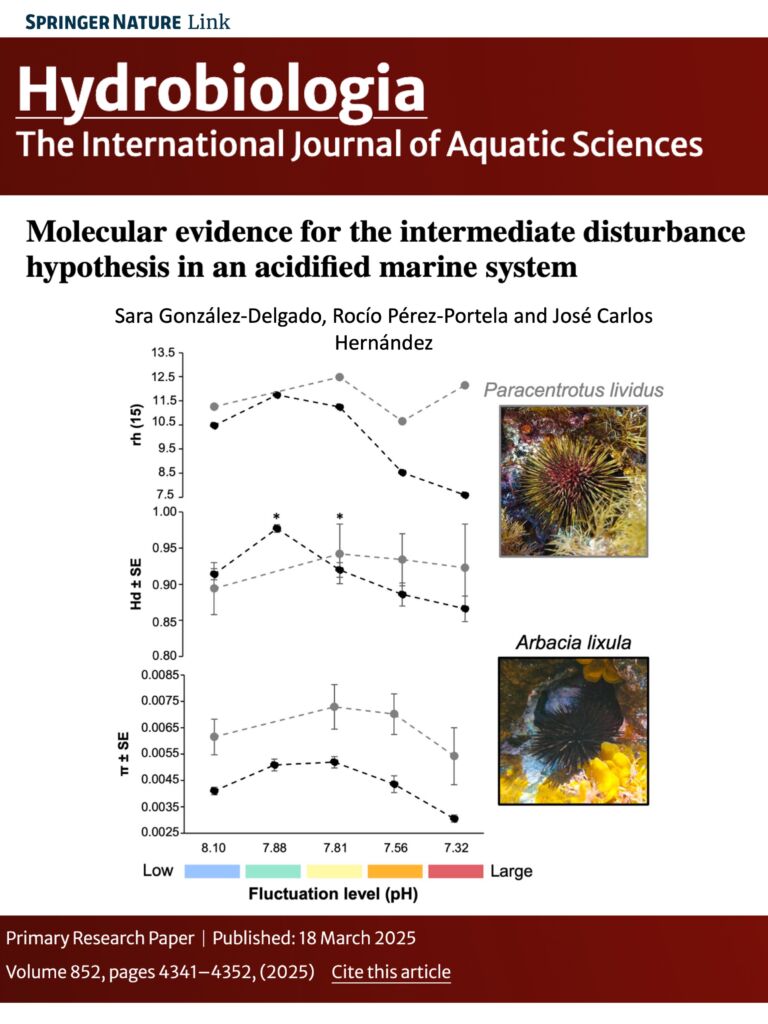Molecular evidence for the intermediate disturbance hypothesis in an acidified marine system

2025. González-Delgado, S., Pérez-Portela, R., & Hernández, J. C. Molecular evidence for the intermediate disturbance hypothesis in an acidified marine system. Hydrobiologia, 1-12.
La Hipótesis de la Perturbación Intermedia (HPI), postulada por Connell (1978), sugiere que los ecosistemas presentan una mayor diversidad de especies cuando las perturbaciones ocurren a escalas intermedias. En este estudio se investigó la aplicabilidad de la HPI a escalas intraespecíficas (nivel individual) utilizando datos moleculares. Como marco experimental de perturbación se muestreó un sistema naturalmente acidificado situado en la isla de La Palma, Islas Canarias (España), caracterizado por un marcado gradiente de pH fluctuante. Se obtuvieron datos moleculares a partir de secuencias de un fragmento del gen mitocondrial de la subunidad I de la Citocromo C Oxidasa en dos especies de erizos de mar (Arbacia lixula y Paracentrotus lividus) para explorar la diversidad genética a nivel individual. Estos datos se compararon con resultados previos de metabarcoding sobre diversidad taxonómica bentónica a nivel comunitario. Ambas especies de erizos de mar mostraron los niveles más altos de diversidad haplotípica y nucleotídica en la zona de fluctuación intermedia de pH, reflejando los datos de metabarcoding que revelaron los niveles más altos de diversidad taxonómica en esa misma zona. Los resultados respaldan la validez de la HPI en ecosistemas marinos afectados por fuertes fluctuaciones de pH y a diferentes niveles de organización biológica (desde organismos hasta comunidades).
English
The Intermediate Disturbance Hypothesis (IDH), postulated by Connell (1978), suggests that ecosystems exhibit higher species diversity when disturbances occur at intermediate scales. In this study, the applicability of the IDH at the intraspecific scales (organismal) was investigated using molecular data. As an experimental perturbation framework, a naturally acidified system located in La Palma Island, Canary Island (Spain) with a sharp fluctuating pH gradient was sampled. Molecular data were obtained from sequences of a fragment of the mitochondrial Cytochrome C Oxidase subunit I gene in two sea urchin species (Arbacia lixula and Paracentrotus lividus) to explore genetic diversity at the organism level. These data were compared with previous metabarcoding results of taxonomic benthic diversity at the community level. Both sea urchin species showed the highest levels of haplotype and nucleotide diversity at the intermediate pH fluctuation zone, mirroring metabarcoding data that revealed the highest levels of taxonomic diversity at the same zone. The results support the validity of the IDH in marine ecosystems affected by strong pH fluctuations and across different levels of biological organization (from organisms to communities).
